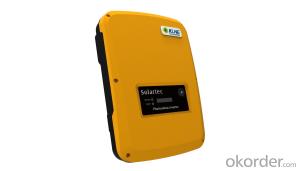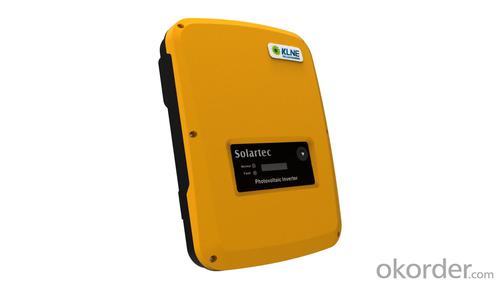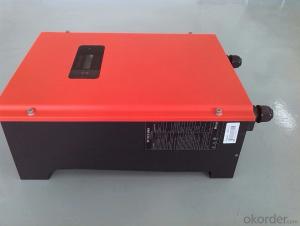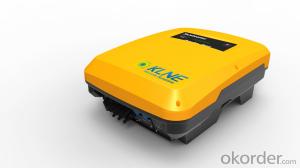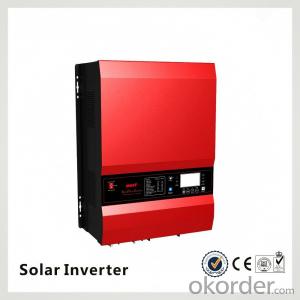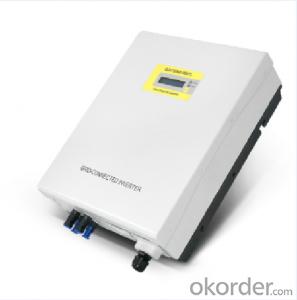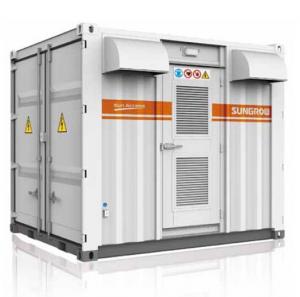10kW Solar Inverter Solartec 1500/2000 On-Grid Inverter
- Loading Port:
- China Main Port
- Payment Terms:
- TT OR LC
- Min Order Qty:
- -
- Supply Capability:
- -
OKorder Service Pledge
Quality Product, Order Online Tracking, Timely Delivery
OKorder Financial Service
Credit Rating, Credit Services, Credit Purchasing
You Might Also Like
The Solartec 1500~5000 series is applicable to various rooftops and small scale photovoltaic grid-connected power plants. Their nominal output powers are 1.5 kW, 2 kW, 2.5 kW, 3 kW, 3.6 kW, 4 kW, 4.6 kW and 5kW respectively.
This series is transformerless and has a wide range of MPPT input voltage. Its maximum conversion efficiency and MPPT tracking accuracy reach 97.6 % and 99.5 % respectively. The maximum DC voltage reaches 550 V. Its multilingual LCD display facilitates easy operation. It has integrated DC switch and waterproof direct plug-in terminals. It has overvoltage, islanding, short-circuit, overloading and overheating protection functions. Its IP65 protection degree will ensure that it runs well in various tough environments.
Efficient
■ Efficiency of up to 97.6 %
■ Transformerless
■ Efficiency of up to 97.6 %
■ Transformerless
Safe
■ Integrated DC switch
■ Comprehensive protection functions
Flexible
■ LCD backlight
■ For indoor and outdoor installation
Simple
■ ‘Plug and play’connection for easy installation
■ Friendly interface, easy to install and maintain
- Q: How does a solar inverter handle harmonics in the grid?
- A solar inverter handles harmonics in the grid by incorporating a built-in filter that helps mitigate the impact of harmonics. This filter is designed to reduce the distortion caused by harmonics, ensuring that the inverter's output adheres to the required grid standards. Additionally, advanced inverters may also employ control algorithms that actively monitor and adjust the output waveform to minimize harmonic distortion and maintain grid stability.
- Q: What is the role of a grid protection relay in a solar inverter?
- The role of a grid protection relay in a solar inverter is to monitor the electrical grid and protect against any abnormalities or faults that may occur. It ensures the safe and reliable operation of the solar inverter by detecting and isolating faults such as overvoltage, undervoltage, overfrequency, underfrequency, and other grid disturbances. The grid protection relay acts as a safeguard, preventing any damage to the solar inverter and maintaining the stability of the grid connection.
- Q: What is the role of a solar inverter in net metering?
- The role of a solar inverter in net metering is to convert the direct current (DC) electricity generated by the solar panels into alternating current (AC) electricity that can be used by the utility grid. It also ensures that any excess electricity generated by the solar panels is fed back into the grid, allowing the consumer to receive credits for the surplus energy produced.
- Q: Can a solar inverter be used with a solar water heating system?
- No, a solar inverter cannot be directly used with a solar water heating system. A solar inverter is specifically designed to convert the direct current (DC) electricity generated by solar panels into alternating current (AC) that can be used to power household appliances or fed into the grid. On the other hand, a solar water heating system utilizes the sun's energy to heat water directly, without the need for an electrical conversion process. Therefore, they are two distinct technologies with different purposes and cannot be directly combined.
- Q: How does a solar inverter handle voltage dips and swells?
- A solar inverter handles voltage dips and swells by utilizing various protective mechanisms. When there is a voltage dip, the inverter typically has a built-in low voltage ride-through capability, which allows it to continue operating even if the grid voltage temporarily drops. The inverter adjusts its power output to match the reduced voltage, ensuring a stable and reliable energy supply. In case of voltage swells, the solar inverter employs voltage regulation techniques to prevent excessive voltage from harming the system. It monitors the grid voltage and adjusts its own output accordingly, ensuring that the generated solar power is safely integrated with the grid. This regulation mechanism helps protect both the inverter and other connected devices from potential damage caused by high voltage levels. Overall, the solar inverter's ability to handle voltage dips and swells is crucial for maintaining the stability and efficiency of a solar power system, enabling it to seamlessly adapt to varying grid conditions and safeguarding the equipment involved.
- Q: How does a solar inverter handle voltage fluctuations in the grid?
- A solar inverter handles voltage fluctuations in the grid by constantly monitoring the grid voltage and adjusting its own output voltage accordingly. When the grid voltage drops, the inverter increases its output voltage to compensate, and conversely, when the grid voltage rises, the inverter decreases its output voltage. This helps to stabilize the voltage and ensure that the solar system remains connected and operational even during fluctuations in the grid.
- Q: What is the power factor of a solar inverter?
- The power factor of a solar inverter typically refers to the ratio of the real power to the apparent power consumed by the inverter. It represents the efficiency of the inverter in converting DC power from the solar panels into AC power for use in the electrical grid. A high power factor indicates a more efficient inverter that minimizes reactive power losses.
- Q: Can a solar inverter be used with a solar-powered electric vehicle charging station?
- Yes, a solar inverter can be used with a solar-powered electric vehicle charging station. The solar inverter converts the DC (direct current) electricity generated by the solar panels into AC (alternating current) electricity, which is required to charge an electric vehicle. By using a solar inverter, the solar-powered electric vehicle charging station can efficiently convert and deliver the electricity generated from solar panels to charge electric vehicles.
- Q: Can a solar inverter be used with concentrated photovoltaic systems?
- Yes, a solar inverter can be used with concentrated photovoltaic (CPV) systems. However, the inverter used for CPV systems may differ from the ones used for traditional photovoltaic systems. CPV systems use lenses or mirrors to concentrate sunlight onto highly efficient solar cells, which generate DC power. This DC power is converted into AC power by the inverter, enabling it to be used for various applications or fed into the grid. Therefore, a specialized inverter designed to handle the unique characteristics and high levels of DC power output of CPV systems is required.
- Q: What is the role of a solar inverter in anti-islanding protection?
- The role of a solar inverter in anti-islanding protection is to detect and prevent the occurrence of islanding, which is when a solar PV system continues to generate electricity and supply power to the grid during a grid outage. The inverter monitors the grid's voltage and frequency, and if it detects a disruption or deviation from the normal range, it quickly disconnects from the grid to ensure the safety of utility workers and prevent damage to equipment. This anti-islanding protection feature helps maintain the stability and reliability of the electrical grid.
Send your message to us
10kW Solar Inverter Solartec 1500/2000 On-Grid Inverter
- Loading Port:
- China Main Port
- Payment Terms:
- TT OR LC
- Min Order Qty:
- -
- Supply Capability:
- -
OKorder Service Pledge
Quality Product, Order Online Tracking, Timely Delivery
OKorder Financial Service
Credit Rating, Credit Services, Credit Purchasing
Similar products
Hot products
Hot Searches
Related keywords
